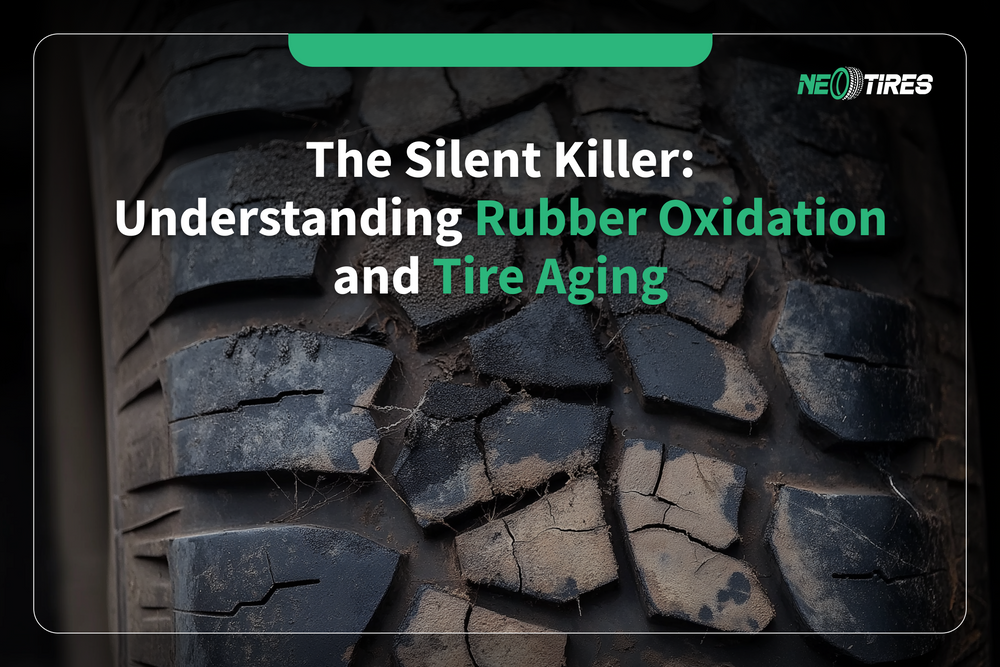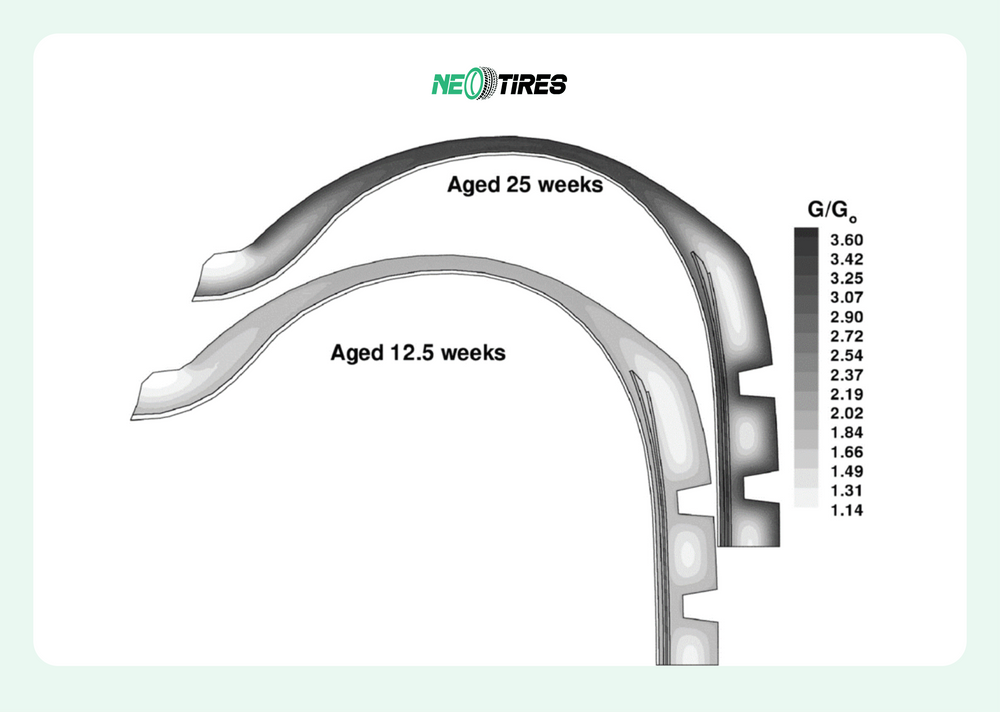Table of Contents:
- The anatomy of tire aging
- The science behind the silent threat
- Combating rubber oxidation: a multifaceted approach
- What this means for you
- Recommendations
Introduction
For car enthusiasts and everyday drivers alike, understanding the lifespan of your tires goes beyond just checking the tread depth. There's a silent threat that can dramatically impact tire performance and safety: rubber oxidation. Research, spearheaded by entities such as NHTSA and Ford Motor Company, has delved into understanding this aging process [1]. This article explains the science behind tire aging, the factors contributing to it, and the measures being taken to combat this silent threat.
Fig. 1. Anatomy of a typical radial tire showing skim and wedge rubber [2].
The Anatomy of Tire Aging
A tire's structure is far more complex than it appears. Within its layers lie vital components like the skim or wedge rubber (Fig. 1), bonding the steel belts for structural integrity [2]. Over time, this rubber, exposed to oxygen, undergoes oxidation – a chemical process similar to rusting in metal [3].
This oxidation is accelerated by heat and exposure to environmental factors, leading to:
- Loss of elasticity: The rubber becomes stiff and brittle, losing its ability to absorb shocks and maintain grip on the road.
- Reduced peel strength: The bond between the steel belts weakens, increasing the risk of tread separation, especially at high speeds.
The Science Behind The Silent Threat
Research highlights that tire aging is primarily an aerobic process [1, 2]. This means that oxygen, permeating through the inner liner from the tire's interior, plays a significant role in the oxidation of the skim and wedge rubber.
Several factors influence the rate of this oxidation:
- Temperature: Higher temperatures drastically accelerate the oxidation process, making hotter climates a significant risk factor (Fig. 2)
- Tire Type: Different tire constructions and compositions, including the type of inner liner used, impact the rate of oxidation.
- Time: Unlike the common belief that tire aging is solely mileage-dependent, research confirms that time plays a crucial role. Even spare tires are susceptible to age-related degradation.
Fig. 2. Distribution of changes in rubber modulus with oxidation at 70°C. The consistent modulus observed in the thick tread sections suggests oxygen starvation within this region. Notably, both the skim and wedge rubber exhibit oxidation at 70°C [1]. Note: G/Go is a ratio representing the change in shear modulus of rubber due to aging. G: Represents the shear modulus of the aged rubber. Shear modulus reflects a material's resistance to deformation under shear stress (think of the force applied when you spread butter with a knife). Go: Represents the initial shear modulus of the unaged (fresh) rubber.
Combating Rubber Oxidation: a Multifaceted Approach
Tire manufacturers are constantly seeking solutions to combat rubber oxidation and improve tire lifespan. Some key strategies include:
- Antioxidant compounds: Special additives within the rubber compound help slow down the oxidation process (such as diphenylamine, phenylenediamine derivatives 6PPD, Butylated hydroxytoluene BHT, butylated hydroxyanisole BHA, and others) [3]
- Nitrogen inflation: Replacing air with nitrogen, which has a lower permeation rate, can help maintain tire pressure and reduce oxidation. It has been shown that nitrogen permeates rubber at only one-third the rate of oxygen [3]
- Advanced inner liner technology: Incorporating high-performance materials like halobutyl rubber in the inner liner significantly reduces oxygen permeation, acting as a barrier against oxidation. For example, studies have reported that increasing the percentage of halobutyl rubber in the inner liner from 60/40 (the remainder being natural rubber) to 100/0 results in a decrease in permeation of over at least a factor of 2 [1].
What This Means For You
Understanding the complexities of tire aging empowers you to make informed decisions about tire maintenance and replacement. Remember:
- Regularly inspect your tires: Look for signs of cracking or deterioration in the sidewall, especially if you live in a hot climate.
- Consider nitrogen inflation: Nitrogen inflation is being used for automobile tires as it significantly slows or even halts changes in tire properties [3]. While it won't stop oxidation completely, it can slow down the process and improve tire pressure retention.
- Don't solely rely on tread depth: Age plays a crucial role in tire safety [1]. Consult your tire's manufacture date and consider replacement even if the tread depth seems adequate.
Tire aging is an unavoidable process, but by staying informed and proactive, you can ensure optimal tire performance and prioritize your safety on the road. Check out the rain effect on tire degradation.
Recommendations
Based on the discussion about tire aging, we recommend considering the options listed below when purchasing new tires to ensure quality, safety, and longevity.
Brand & Model | Type | Lifespan | UV Resistance | Ozone Resistance | Heat Resistance | Comfort | Noise | Wear | Dry Handling | Wet Handling | Overall Rating |
Continental | Touring | 5 | 5 | 5 | 5 | 5 | 5 | 5 | 4 | 4 | 4.8 |
Continental | Touring | 5 | 5 | 5 | 5 | 5 | 5 | 5 | 4 | 4 | 4.8 |
Continental | SUV/ Crossover | 5 | 5 | 5 | 4 | 5 | 5 | 5 | 4 | 4 | 4.7 |
Pirelli | Winter | 4 | 5 | 5 | 5 | 4 | 4 | 4 | 4 | 5 | 4.4 |
Cooper | Winter | 4 | 5 | 5 | 5 | 4 | 4 | 4 | 4 | 5 | 4.4 |
Cooper | Touring | 4 | 5 | 4 | 4 | 5 | 5 | 4 | 4 | 4 | 4.3 |
Continental | All-Season | 4 | 4 | 4 | 4 | 4 | 4 | 4 | 5 | 5 | 4.2 |
Pirelli | Performance | 4 | 4 | 4 | 4 | 4 | 4 | 4 | 5 | 5 | 4.2 |
Pirelli | All-Season/ SUV | 4 | 4 | 5 | 4 | 4 | 4 | 5 | 4 | 4 | 4.2 |
Pirelli | All-Season | 4 | 4 | 4 | 4 | 5 | 5 | 4 | 4 | 4 | 4.2 |
Yokohama | All-Terrain | 4 | 5 | 5 | 4 | 4 | 4 | 4 | 4 | 4 | 4.2 |
Falken | All-Terrain | 4 | 4 | 4 | 4 | 4 | 4 | 4 | 5 | 4 | 4.1 |
Falken | Performance | 4 | 4 | 4 | 4 | 4 | 4 | 4 | 5 | 4 | 4.1 |
Yokohama | All-Season | 4 | 4 | 4 | 4 | 4 | 4 | 4 | 5 | 4 | 4.1 |
Continental | All-Terrain | 4 | 4 | 4 | 4 | 4 | 4 | 4 | 4 | 4 | 4.0 |
Cooper | All-Terrain | 4 | 4 | 4 | 4 | 4 | 4 | 4 | 4 | 4 | 4.0 |
*The following ratings are based on general industry knowledge and customer reviews. They represent typical performance expectations for each tire model.
References:
[1]. Baldwin, J. M., & Bauer, D. R. (2008). Rubber oxidation and tire aging: A review. Rubber Chemistry and Technology, 81(4), 338–358.
[2]. Baldwin, J. M., Bauer, D. R., & Ellwood, K. R. (2007). Rubber aging in tires: Part 1. Field results. Polymer Degradation and Stability, 92(1), 103–109.
[3]. Sommer, J. G. (2009). Engineered rubber products. Hanser Publishers.







